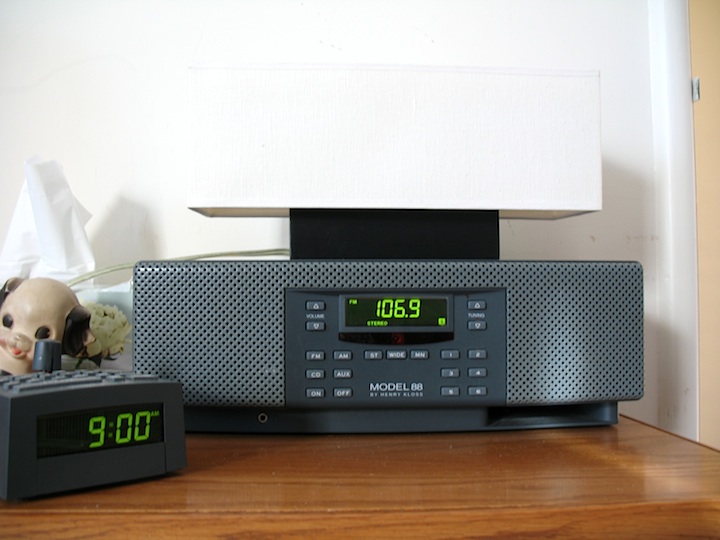
Here's the radio I use every day to wake up. It's a Cambridge Soundworks Model 88, bought in 2000 at a Cambridge Soundworks store, along with the clock, which is separate. The first clock gave out about three months after I bought it. The store gave me a replacement clock, no questions asked. It's still working although the chassis of the clock is a bit loose within the case.
The clock stopped working once in 2014, but I was able, in effect, to "reboot" it by taking out the 9-volt battery that it uses for power backup and leaving it out for a few minutes. That cleared all the alarm settings on the clock; still, the clock started working again. When this review was revised in 2020, the clock was still working.
As you would expect with a radio designed by Henry Kloss (such as the Advent 400), the sound is excellent. The radio has a subwoofer, a port speaker with an opening at the lower right of the radio. It's stereo. A "wide" switch provides the illusion of greater stereo separation. There is a headphone jack in the front and input jacks for two sets of audio sources, labeled "CD" and "AUX", on the back of the radio. There's no tone control, but there is an adjustment for the subwoofer in the back. I have it turned almost all the way down and it still sounds quite powerful.
The subwoofer easily overpowers the rest of the sound on the radio. The only way around that, I've found, is to keep the subwoofer level very low. It doesn't affect the sound through the headphone jack.
Tuning is done either with up-and-down buttons ("skew" buttons) or through using presets (six for AM and FM each). Tuning is in 10 kHz steps on AM and 200 kHz steps on FM, which works fine for the Western Hemisphere, but not elsewhere. I don't know if there were versions of this radio made for regions outside North America.
There's a remote control that duplicates the functions on the front panel of the radio. However, it can't be used to store stations in memory. That has to be done through the front-panel buttons.
FM performance is sensitive, though not all that selective, and free from front-end overload. For the most part, it can pick out moderately weak signals on the crowded San Francisco Bay Area FM dial, though it will miss the very weakest stations.
The original version of this review was critical of the radio's AM performance. While I use this radio mostly for FM reception, it's more than adequate for AM performance as well. My earlier criticism of the radio focused on reception of out-of-market stations that still put a reasonably good signal into the Bay Area. I cited the example of Sacramento's KFBK (1530 kHz). Upon subsequent listening just before I revised this review in 2020, I found that the radio received KFBK with a steady but slightly noisy signal. So I can now rate the AM performance as good to very good.
The audio quality on AM isn't exceptional. Audio response is down 6B at 2.2 kHz, gradually declining at higher frequencies: down 10 db at 3.8 kHz and then practically nonexistent (-40 dB) at 10 kHz. While not high-fidelity on AM, the sound is still somewhat pleasant.
My 36-year-old Advent 400, another Kloss creation, has more natural sound. But it's mono only, and it doesn't have a clock. As a clock radio, the Model 88 is very good. Especially nice is the way it ramps up the volume upon turning on. For a clock radio, that's just a little less jarring than having the radio turn on instantly at full volume.
So, while there are a few things that detract, overall, I've been quite satisfied with the Model 88 over 20 years of use.